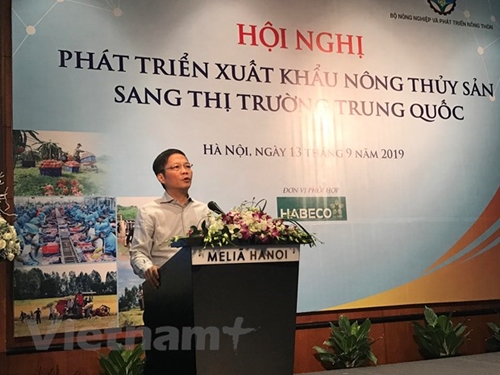According to Deputy Director of the Agency of Foreign Trade under the Ministry of Industry and Trade (MoIT) Tran Thanh Hai, Vietnam’s agro-aquatic product export turnover in the first eight months of 2019 was estimated at 16.6 billion USD, down 7.2 percent year-on-year.
    |
 |
|
Minister of Industry and Trade Tran Tuan Anh speaks at the conference |
Notably, export growth to China has slowed down significantly in the recent time due to China’s intensifying implementation of regulations from mid-2018 on tracing the origin of products, inspecting the quarantine of plants and animals and the quality of imported agricultural and aquatic goods, Hai said.
He added that Vietnam will meet difficulties in exporting such products to China amid fluctuations of regional and global markets such as the decline in China’s domestic demand and the impact of China-US trade conflict.
Moreover, China is strictly enforcing regulations on the import of agricultural and aquatic products on the land border areas through measures to strengthen supervision of traceability, packaging, and food safety and hygiene, Hai noted.
Minister of Industry and Trade Tran Tuan Anh said difficulties in exporting to China have existed for many years although ministries and businesses have made great efforts to resolve them. However, at this time, it must be changed because China has increasingly applied barriers and high and strict requirements related to product quality, food safety, traceability and brand building.
According to Minister of Agriculture and Rural Development Nguyen Xuan Cuong, China has applied one official trade form for exports and imports from June 1, rather than various forms of import and export, including border trade, which is the main way Vietnamese products reach China.
Besides, China also has had a change in management, in which all procedures of import and export will be solved by the General Department of Customs, Cuong said, adding that if businesses don't catch up and transform in time, they will be landed in an embarrassing situation.
Le Hoang Oanh, Director of the MoIT’s Asia-Africa Market Department, recommended businesses focus on production according to plans, which must be based on demand, market capacity and season.
Besides, it was necessary to promote national trade promotion programmes in China, building distribution and consumption channels in the country, she added.
Oanh suggested focusing on official exports to cut legal risks as well as gradually building brands and improving quality, safety and product design, meeting requirements on packaging, labels, traceability, factory registration and growing areas.
Vietnam and China have signed the ASEAN-China Free Trade Agreement (ACFTA), which came into effect in 2010, with tariffs reduced to zero for 8,000 product lines. It has great potential for Vietnamese agricultural and aquatic products to be exported to China.
Source: VNA